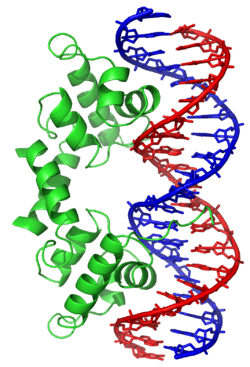Protein–DNA interaction

Protein–DNA interactions are when a protein binds a molecule of DNA, often to regulate the biological function of DNA, usually the expression of a gene. Among the proteins that bind to DNA are transcription factors that activate or repress gene expression by binding to DNA motifs and histones that form part of the structure of DNA and bind to it less specifically. Also proteins that repair DNA such as uracil-DNA glycosylase interact closely with it.
In general, proteins bind to DNA in the major groove; however, there are exceptions.[1] Protein–DNA interaction are of mainly two types, either specific interaction, or non-specific interaction.
Design
Designing DNA-binding proteins that have a specified DNA-binding site has been an important goal for biotechnology. Zinc finger proteins have been designed to bind to specific DNA sequences and this is the basis of zinc finger nucleases. Recently transcription activator-like effector nucleases (TALENs) have been created which are based on natural proteins secreted by Xanthomonas bacteria via their type III secretion system when they infect various plant species.[2]
Detection methods
There are many in vitro and in vivo techniques which are useful in detecting DNA-Protein Interactions. The following lists some methods currently in use:[3]
- Electrophoretic mobility shift assay is a widespread technique to identify protein-DNA interactions.
- DNase footprinting assay can be used to identify the specific site of binding of a protein to DNA.
- Chromatin immunoprecipitation is used to identify the sequence of the DNA fragments which bind to a known transcription factor. This technique when combined with high throughput sequencing is known as ChIP-Seq and when combined with microarrays it is known as ChIP-chip.
- Yeast One-hybrid System (Y1H) is used to identify which protein binds to a particular DNA fragment.
- Bacterial one-hybrid system (B1H) is used to identify which protein binds to a particular DNA fragment.
- Structure determination using X-ray crystallography has been used to give a highly detailed atomic view of protein-DNA interactions.
See also
- DNA-binding protein
- Protein-protein interaction
- ChIP-exo
- Protein–DNA interaction site prediction software
References
- ↑ Bewley CA, Gronenborn AM, Clore GM (1998). "Minor groove-binding architectural proteins: structure, function, and DNA recognition". Annu Rev Biophys Biomol Struct. 27: 105–31. doi:10.1146/annurev.biophys.27.1.105. PMID 9646864.
- ↑ Clark KJ, Voytas DF, Ekker SC (September 2011). "A TALE of two nucleases: gene targeting for the masses?". Zebrafish. 8 (3): 147–9. doi:10.1089/zeb.2011.9993. PMC 3174730
 . PMID 21929364.
. PMID 21929364. - ↑ Cai YH, Huang H (July 2012). "Advances in the study of protein-DNA interaction". Amino Acids. 43 (3): 1141–6. doi:10.1007/s00726-012-1377-9. PMID 22842750.